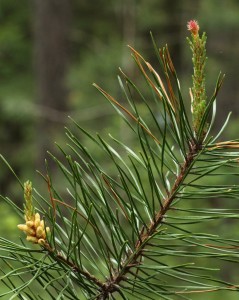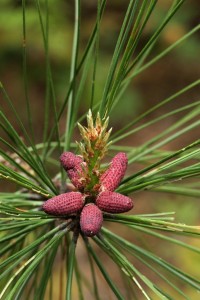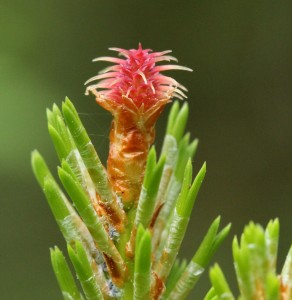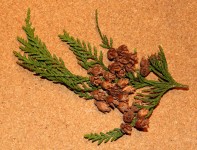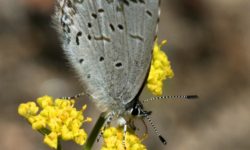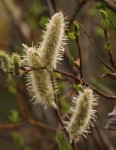You may have noticed a yellow dust on your car or around the edges of puddles recently. The visible yellow dust is only a fraction of the pollen that is being released from conifers.
Spring is a time for pollination and conifers are no exception. Conifers are subtle in their pollination since they don’t produce flowers. Instead, pollination and seed development occurs in cones.
Brown “pine cones” are what first come to mind, but they are actually the end product. Conifers produce two types of cones: pollen cones and seed cones.
Pollen cones are small and often fall off the tree once the pollen has been dispersed. Pollen cones on pine trees cluster at the base of new shoots (called candles) and are fairly visible now.
Since wind helps pollinate conifers, each pollen cone releases an astronomical amount of pollen–up to two million grains per pine or spruce cone–to ensure that at least one pollen grain lands on an ovule in the seed cone.
The seed cone is where fertilization and seed development takes place. To increase the likelihood of seed production, the seed cones often form on the uppermost branches where they are exposed to more wind-blown pollen.
Pollen cones are typically located below the seed cones to prevent self-pollination. However, seed cones can chemically recognize pollen from the same tree and will not accept it.
Initially seed cones can be as small as the pollen cones and can be hard to locate, but they grow with seed development. Each seed cone, for the most part, consists of numerous scales with ovules between the scales. The ovule develops into the seed.
Fleshy yew and juniper seed cones resemble fruit more than a woody cone, but they are conifers because of the naked seed. All conifers are gymnosperms, which means that the seeds are not enclosed by fruit at maturity.
Some conifers, such as cedar, develop seed in one growing season. Others, such as pines and Douglas-fir, require two growing seasons to develop seed with rapid enlargement of the seed cone the second summer.
For pine seed cones that are pollinated this spring, fertilization will occur next spring. The movement of the pollen grain from the outside of the ovule to the inside takes over a year.
Typically once the seeds are mature, the cone changes color from green to brown, the scales of the seed cone spread apart and the seeds fall out. Lodgepole pine cones remain closed when mature and require fire to melt the resin and release the seeds.
The size of the seed is determined by how it is disbursed–wind or animals. Seeds dispersed by wind, such as Ponderosa pine seeds, are small and have wings whereas animal-dispersed seeds, such as whitebark pine seeds, are larger with no wings. The average weight of Douglas-fir seeds is approximately 40,000 per pound.
Some seed cones fall off the tree when the seeds are mature, others stay on the tree and disintegrate. Black spruce cones remain on the tree for 20 to 30 years.
Whitebark pine cones disintegrate on the tree before dispersing seeds but animals, such as Clark’s nutcrackers and squirrels, usually harvest the seeds first.
Conifers produce astronomical amounts of yellow pollen and prolific amounts of seed to increase the likelihood that a least one seed will germinate and continue the cycle.

